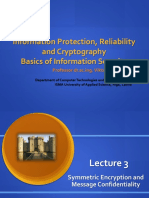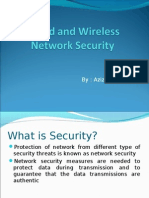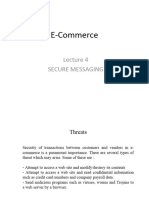0% found this document useful (0 votes)
41 views31 pagesLecture 07 - Cryptography III - Symmetric-Key Algorithms
The lecture covers symmetric-key algorithms in cryptography, focusing on encryption techniques such as block and stream ciphers, and the importance of choosing trusted algorithms. It discusses various symmetric encryption standards like DES, 3DES, and AES, highlighting their characteristics, strengths, and weaknesses. Additionally, it emphasizes the need for secure key management and the evaluation of encryption algorithms based on their resistance to attacks.
Uploaded by
ASHEN AMANTHACopyright
© © All Rights Reserved
We take content rights seriously. If you suspect this is your content, claim it here.
Available Formats
Download as PPT, PDF, TXT or read online on Scribd
0% found this document useful (0 votes)
41 views31 pagesLecture 07 - Cryptography III - Symmetric-Key Algorithms
The lecture covers symmetric-key algorithms in cryptography, focusing on encryption techniques such as block and stream ciphers, and the importance of choosing trusted algorithms. It discusses various symmetric encryption standards like DES, 3DES, and AES, highlighting their characteristics, strengths, and weaknesses. Additionally, it emphasizes the need for secure key management and the evaluation of encryption algorithms based on their resistance to attacks.
Uploaded by
ASHEN AMANTHACopyright
© © All Rights Reserved
We take content rights seriously. If you suspect this is your content, claim it here.
Available Formats
Download as PPT, PDF, TXT or read online on Scribd
/ 31
























































































